![]() 1st Battalion 22nd Infantry
1st Battalion 22nd Infantry ![]()
Captain David P. Wheeler
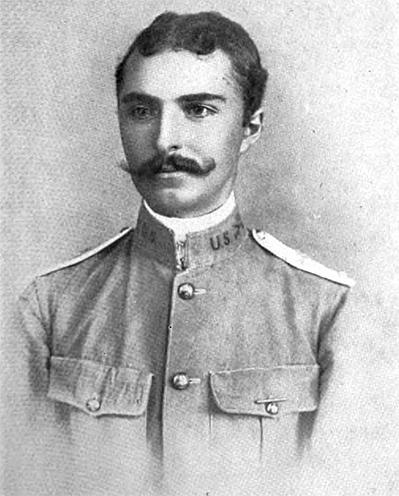
David P. Wheeler as a Lieutenant.
He wears the model 1898-1899 khaki Field Service uniform
with white shoulder straps, to denote Infantry branch.
Photo from the Thirty-Sixth Annual Reunion
book of the Association of Graduates
of the United States Military Academy 1905
David Porter Wheeler was born in Zanesville, Muskingum County, Ohio on July 18, 1876.
He graduated from the US
Military Academy at West Point on April 26, 1898, and on that
date was commissioned
a 2nd Lieutenant in the 23rd Infantry. This was the day after the
formal Declaration of War against the Kingdom of Spain
by the United States. The normal graduation time of June or July
had been advanced because of the impending war.
At that time the 23rd Infantry
was at New Orleans, in preparation for possible deployment to
Cuba.
The following month the Regiment moved to San Francisco, with
orders to deploy to the Philippines.
Assigned to Company F, Wheeler was part of the 1st Battalion,
commanded by Lieutenant Colonel
John W. French. In June 1898 the 1st Battalion of the 23rd
Infantry sailed to the Philippines,
and Wheeler was part of the force opposing the Spanish at Manila
on August 13 of that year.
The following is the
after-action report, written by Wheeler, of an engagement of the
23rd Infantry
with Spanish forces near Manila, in which he participated:
MANILA, P. I., August 23, 1898
COMMANDING OFFICER COMPANY F.
SIR: I have
the honor to report that on Friday morning, August 5, Company F
left Camp Dewey for outpost duty
and reached the trenches about 9.30 a. m. We were assigned to the
part of the line crossing a rice field,
about 100 yards from the main road to Manila. Two small
earthworks had been thrown up when we took
possession. I was given command of the one to the right, with 30
men; the remainder of the company,
under Captain Clagett, were behind the other intrenchment, about
50 yards to my left; Company D
was about 70 yards to my right and rear; Company H about 100
yards to the rear of Captain Clagett's position.
During the day the Spanish sharpshooters kept up an annoying fire
at us, but only twice did the men
have to stop work on the intrenchments, which were extended about
20 yards and strengthened. About 10 yards
to my right a dense hedge ran perpendicular to our line and a
corresponding one on the left. The ground
immediately in my front
was open for about 200 yards and then several clumps of trees
afforded some cover.
At 7.15 p. m. the enemy opened fire on us, which was replied to
on my right and left. Their firing increased,
and I replied first with fire at will and, as their firing
increased and came much closer, by volleys.
They advanced to within about 200 yards of my work in front and
to within 150 yards along the hedge to the right.
I was prevented from firing into the hedge by the position of the
insurgent lines to our right. The enemy
were prevented from advancing along this hedge by the fire from
Company D. The Spanish were out in force,
and, judging from the flashes, seemed to be firing by volley when
they were closest to us. After an hour and a quarter
of incessant firing the enemy withdrew, although their
sharpshooters kept up a harassing fire until we were relieved.
At no time did we make
any reply to their sharpshooters nor molest them as they worked
on their trenches
in plain sight of us. We were relieved about 9.30 a. m. Saturday
and returned to Camp Dewey. The next day I was
told by an insurgent officer who had seen the Spanish forces that
there were between 600 and 700 of them
in our front during the attack and that they suffered heavy
losses before they retired.
Very respectfully,
D. P. WHEELER, Second Lieutenant Company F, Twenty-third Infantry.
In September of 1898 the war
with Spain came to an end, but on February 4, 1899, David Wheeler
found himself
in a new war, this time against soldiers of the 1st Philippine
Republic.
On March 2, 1899 Wheeler was
promoted to 1st Lieutenant and transferred to the 22nd Infantry.
At the end of that same month, on March 27, the 22nd Infantry
received a new Regimental Commander,
newly promoted Colonel John French, who had been Wheeler's
Battalion Commander in the 23rd Infantry.
Wheeler served at Candaba,
Luzon, Philippine Islands, July 17 to October, 1899. He was in
the field in Luzon
(Province) from October 1899 to June 1901. He is recorded in the
Official Army Register of 1901 as being
assigned at that time to Company A 22nd Infantry, with Captain
Joseph Donovan commanding the Company.
Donovan was severely wounded in an engagement with insurgent
forces near Las Pinas on June 13, 1899,
at which time Wheeler assumed temporary command of the Company.
On January 3, 1901, with Donovan
back in the United States recuperating from his wounds, Wheeler,
as
Commander of Company A, wrote a report of deceased members of the
Company in the Philippines
up to that time. The folllowing is a scan of David P. Wheeler's
signature from that original report:
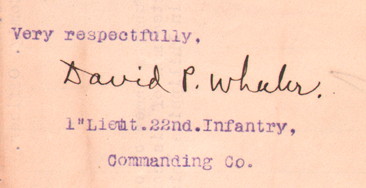
The following passages from the
1904 Regimental History, for the years 1900 and 1901, and the
Annual Reports
of the War Department for 1901, give an indication of the duties
performed by Wheeler during this phase
of the Regiment's service in the Philippines:
1900
October
2.—Lieut. Wheeler, with a detachment of company A, struck a
band of insurgents in barrio of Santo Tomas, near Jaen;
killed one, captured two, two rifles and valuable papers. No
casualties.
Lieut. Wheeler,
with forty men of company A, encountered an insurgent outpost
near San Pablo;
killed one insurgent and captured two rifles. No casualties.
October
11.—Lieut. Wheeler, with a detachment of company A, captured
in woods, near barrio of Jaen,
Comandante Delfin Esquivel and three soldiers, six rifles, and
500 rounds of ammunition.
Jaen.—November
4. Detachment of Company A, under First Lieutenant Wheeler,
Twenty-second Infantry,
marched to San Pablo to intercept band of insurgents repulsed at
Manicling. No result. Distance marched, 8 miles.
November 5.
Companies A and K, under First Lieutenants Wheeler and Hannay,
cooperated with Companies I and M,
all commanded by Captain Crittenden, Twenty-second Infantry.
Thorough search made of country in vicinity of San Antonio,
Nueva Ecija. No result. Distance, 9 miles.
November 9.
Detachment Company A, under First Lieutenant Wheeler, marched to
barrio Lelina, near San Antonio.
Two insurgents captured. Rest escaped. Distance, 10 miles.
November 16.—Lieut Wheeler, with detachment of 22nd infantry, captured, near Tombo, six insurgents, five rifles, and one revolver.
November 16.
Detachment Company A, under Lieutenant Wheeler, surprised party
near Tambo. Captured 1 corporal,
5 men, 2 Remington carbines, 2 Mauser rifles, 1 revolver.
November 17.
Mounted men Company A, under Lieutenant Wheeler, mounted men
Company I, under Lieutenant Leonard,
Twenty-second Infantry, and detachment Company K, under
Lieutenant Hannay, all under Captain Crittenden, marched to
Santo Cristo, near Gapan, Nueva Ecija, and captured early in the
morning 31 men, of whom 8 were soldiers. Distance, 20 miles.
December
21.—Lieut. Wheeler, acting on information from spies,
captured the insurgent captain Esteban Quinteros;
prisoner led them to the camp of twenty-eight of his men near
Jaen. Lieut. Wheeler attacked camp in darkness; killed two,
wounded one, captured eight rifles and 300 rounds of ammunition.
No casualties.
1901
January
20.—Lieut. Wheeler, with a detachment of company A, met a
band of insurgents near Jaen; routed them, captured six rifles,
three shotguns, one revolver, and 300 rounds of ammunition. No
casualties.
February 24-25. Lieutenant Wheeler with mounted detachment, 12 men, scouted country between Jaen and Zaragoza.
Wheeler left the Philippines in
June 1901, arrived in the United States on July 28, 1901, and was
on leave
until October 28, 1901. From that date until April 8, 1902, he
was on duty at Columbus Barracks, Ohio.
The nature of this duty is not specified, however, Columbus was a
major recruiting depot at that time,
so his duty there was most likely as a recruiting officer.
From April 8, 1902 to May 9,
1902, he was assigned to Command of a
Company at Fort Robinson, Nebraska. Which Company he commanded at
Fort Robinson is not specified.
In early 1902 the 22nd Infantry Regiment had returned to the
United States, and its various Companies were stationed
at several Forts in Nebraska, and one Fort in Arkansas. Companies
A and D were posted to Fort Robinson at this time.
The Army Register for 1902 shows Wheeler still officially
assigned to Company A.
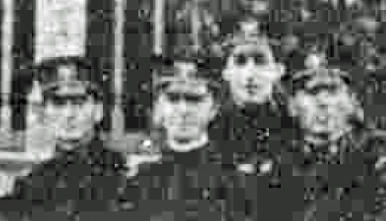
Officers of the 22nd
Infantry at Fort Crook, Nebraska 1903.
Captain David P. Wheeler is second from the left.
Photo from the Omaha Daily
Bee, October 11, 1903
University of Nebraska, Lincoln , Nebraska State
Historical Society
On May 9, 1902, Wheeler and
Companies A and D moved to Fort Reno, Indian Territory
(Oklahoma).
While at Fort Reno he was promoted to Captain of the 26th
Infantry, on January 27, 1903. On March 20, 1903,
Wheeler left Fort Reno for duty station at Fort Crook, Nebraska.
On April 7, 1903, he was transferred back
to the 22nd Infantry. He left for the Philippines with the 22nd
Regiment at the end of October 1903, arriving in Manila
aboard the USAT Sheridan, on November 28, and then to Camp
Marahui, Island of Mindanao, on December 6, 1903.
On Mindanao, as Commanding
Officer of Company F 22nd Infantry, Wheeler was part of Major
General Leonard Wood's
Taraca Expedition, which took place April 2-11, 1904. The aim of
this Expedition was to bring under American control
the Moros who held sovereignty over the region southeast of Lake
Lanao, along the Taraca River. The mission was a success,
and all units involved returned to their duty stations on April
11, with the exception of Companies F and G of the
22nd Infantry, who were left as a garrison at the captured Moro
fort, or "cotta", at Sapungan, at the mouth
of the Taraca River. Wheeler, as the senior Captain of the two
Companies, was therefore in charge of the small post.
The Regimental History of 1904 describes the action of April 11:
"...the
same companies ( Company F and Company G), while reconnoitering
up the Taraca river,
encountered a cotta containing a number of armed Moros. Before
attacking, Captain Wheeler, commanding,
ordered the women and children to a place of safety. The men of
the cotta denied having guns, but professed
their willingness to come out and to surrender. While giving up
their kampilans and daggers, a number of them,
without warning, made a rush upon the troops and succeeded in
stabbing Captain David P. Wheeler and
Corporal Percy Heyvelt, company F. The troops at once opened fire
upon the treacherous Moros, killing thirty of them."
Wheeler died of his wounds
either two or three days later. (His death is reported in
different accounts
as occurring on either April 13 or 14.) The post at the mouth of
the Taraca River was named Camp Wheeler
in his honor. Cullum's Biographical Register of 1910 mentions
that:
"He was commended in general orders, for his conduct of affairs in Taraca Valley during April, 1904."
General Orders Number 5, of the 22nd Infantry for the year 1904, memorialized Wheeler :
GENERAL ORDERS No. 5
HEADQUARTERS 22ND U.S.
INFANTRY
CAMP MARAHUI, MINDANAO, P. I.
April 14th, 1904
It is the painful duty of
the Regimental Commander to announce the death of an officer,
Captain David Porter Wheeler, 22nd infantry,
who succumbed this date to wounds inflicted by hostile Moros at
Taraca river, on Lake Lanao, April 11, 1904. Captain Wheeler
was born in Zanesville, Ohio, July 18, 1876. Appointed to the
military academy, June 15, 1894. Graduated and commissioned
a second lieutenant in the 23rd infantry on April 23, 1898.
Promoted first lieutenant and assigned to the 22nd infantry,
March 2, 1899.
Promoted captain and assigned to the 26th infantry, January 27,
1903. Transferred to the 22nd infantry, April 7, 1903.
The regiment sustains a heavy loss by the death of this gallant
officer, whose service has ever been characterized by loyalty,
gallantry,
and efficiency of the highest order. He was much beloved by his
comrades, and his name will always be remembered with those
heroic men
of the regiment who have given their lives for their country. The
flag will be placed at half mast until after the funeral
and mourning will be for thirty days.
BY ORDER OF LIEUTENANT
COLONEL MAUS:
(Sgd.) J. L. DONOVAN, Captain 22nd Infantry, Acting Adjutant.
The above order was written and
signed by Captain Joseph L. Donovan, as Acting Adjutant of the
22nd Infantry.
When David Wheeler had been a 1st Lieutenant in Company A of the
22nd Infantry, Donovan had been his
Company Commander. The following account of Wheeler's death was
written by Captain Donovan, and published
in Combat Diary by A. B. Feuer:
Captain Donovan
continued his account: "...During the afternoon, two
Filipinos—who had been slaves of one of the sultans—
came in under a flag of truce.
"On April
8, we camped near the mouth of the Ramaien River. These marches
were made through swamps and unbridged streams.
We did not stop until late in the day, as many halts were
necessary in order to investigate nearby cottas.
"The liberated slaves had told us of a cotta at Pitud. It
belonged to Datto Gadapuan and was reported to contain many
rifles
and a large quantity of ammunition. Companies F and G, under
Captain David Wheeler, were sent to investigate.
Upon approaching the cotta, Wheeler's detachment came under heavy
fire. For several minutes the Americans were pinned down
in the swampy ground. Finally Corporal Sam Treadway exclaimed
that he would rather face the datto's bullets than have
snakes and leeches crawling all over his body. Captain Wheeler
was of the same opinion and yelled for his men to charge the
cotta.
Attempting to outscream the Moros, Company F busted through the
bamboo gate. It was hand-to-hand battle.
A Moro swung his kris at Treadway. The corporal wrestled the
knife away from the native and killed him with his own weapon.
Treadway and three other soldiers were wounded in the
melee—but the cotta was quickly captured.
"With the
exception of Wheeler's battle, our march through the hostile
countryside was unopposed. Although the mud was
knee-deep, outlandishly attired delegations of flag-waving Moros
continued to greet our column—pledging their allegiance
to the United States. Colonel Maus was offered presents of
fruits, chickens, and eggs—no strings attached—so they
said.
One procession was led by a native carrying a large flag taken
from an American transport vessel. We thought it best
not to ask him where he obtained the banner."
Captain Wheeler
and his men were sent on ahead to reconnoiter upstream along the
banks of the Taraca River.
During the afternoon of the 10th, they came upon a large cotta.
Since women and children were reported to be inside,
Wheeler attempted to negotiate a surrender. The natives inside
the cotta denied having guns but said they were willing
to give up their other weapons.
Wheeler was
dubious, and as women and children emerged from the bamboo
doorway, he ordered them taken to a safe place.
A few tribesmen then appeared and walked slowly out from the
fort—dropping their bolos on the ground. Seconds later,
fifty screaming Moros dashed from the cotta—slashing the air
with their long knives. Captain Wheeler was immediately stabbed
through the heart. The Americans were shocked for a
moment—then a hail of bullets met the charging enemy.
When the smoke cleared, there was not one Moro warrior
standing—thirty were killed outright.
The following obituary and
biography of Wheeler was published in the Thirty-Sixth Annual
Reunion
of the Association of Graduates of the United States Military
Academy at West Point, New York,
June 13th, 1905.
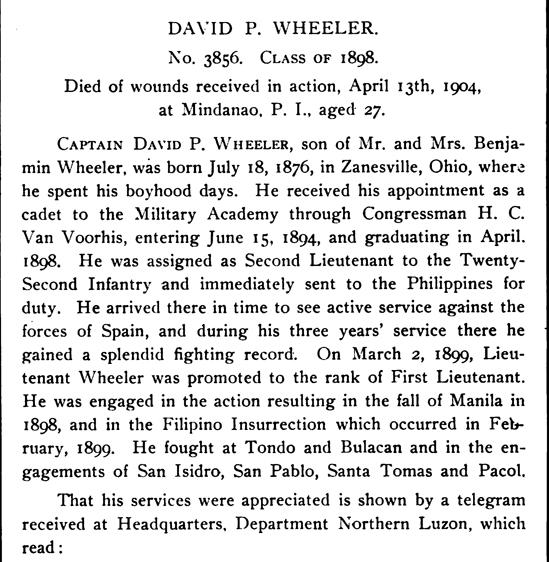
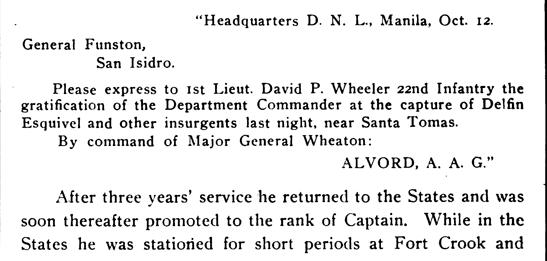
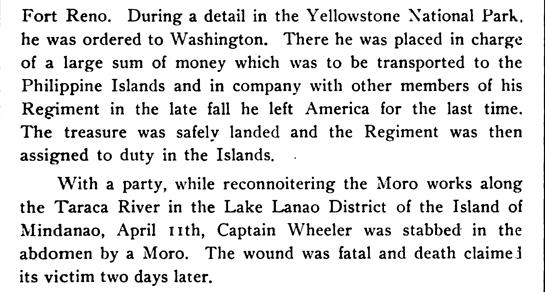
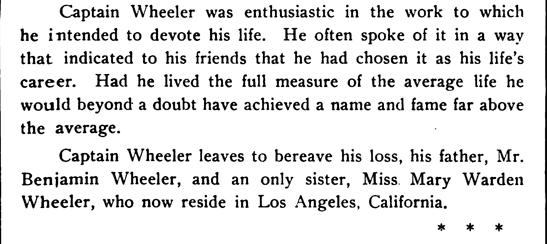
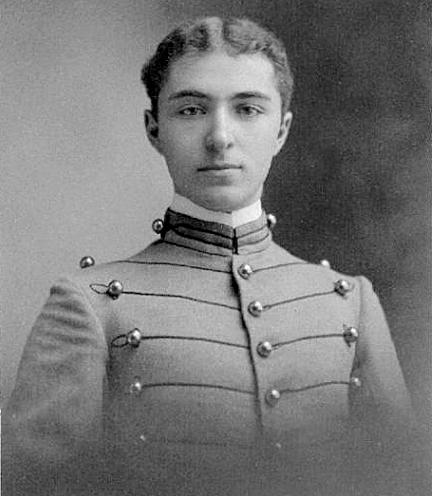
David Porter Wheeler as a Cadet at the
U.S. Military Academy.
He graduated 48 out of a class of 59. His best subjects were
Drill Regulations and
Mathematics. His worst subjects were Practical Military
Engineering and Spanish.
Photo from the USMA Class Album of 1898.
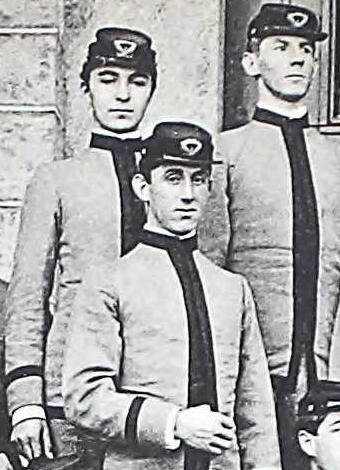
David P. Wheeler (back row far left) as a cadet at West Point 1897
Photo from the USMA yearbook the Howitzer 1897
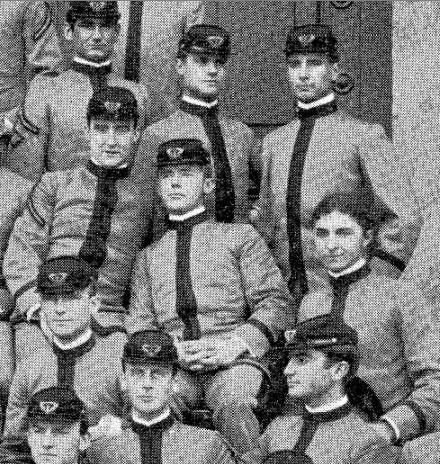
Part of the graduating class of 1898,
US Military Academy.
Wheeler is in the second row, far right. He is the only one
in the photo not wearing a cap.
Photo from the USMA Class Album of 1898.
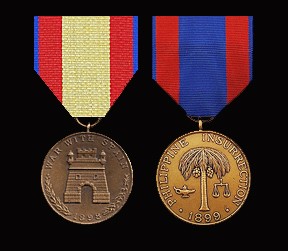
Captain David P. Wheeler's decorations
The following clipping is from the San
Francisco Call, Saturday, April 16, 1904.
It announces the death of David P. Wheeler, and mentions that
Corporal Percy Heyvelt
was "fatally wounded". The 1904 22nd Infantry
Regimental History does not indicate
that Heyvelt died, only that he was wounded.
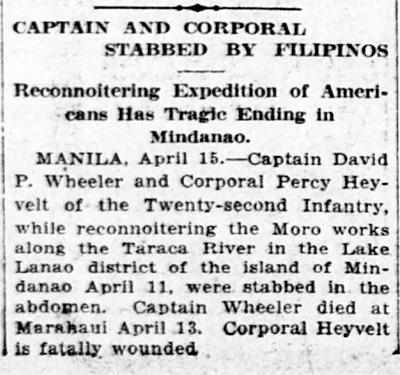
Also on Saturday, April 16, 1904, the Los
Angeles Herald
announced the death of David Wheeler, with the following two-part
short article,
a byline of which stated that Wheeler was the "Youngest
Captain in Army".
|
|
|
The article in the Los
Angeles Herald Below is an enlargement of the
bottom part The statement that he was
killed by He was killed by Moro tribesmen |
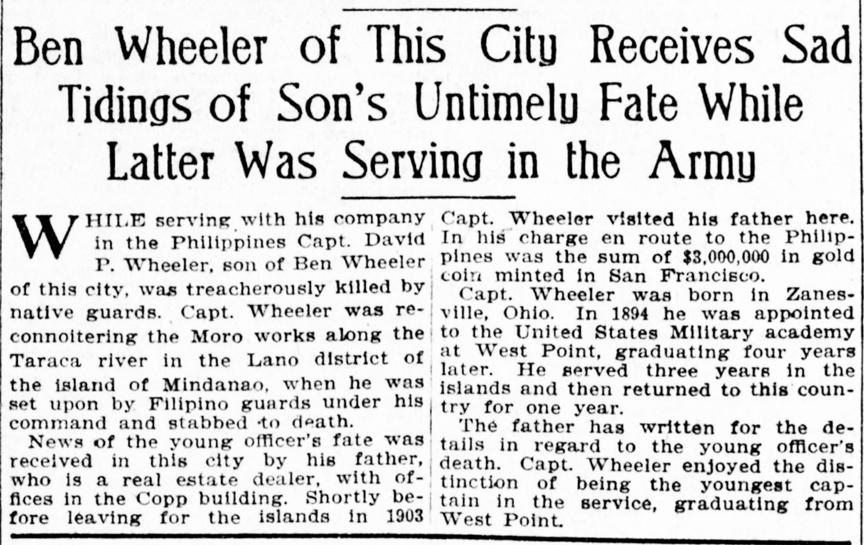
The sum of three million dollars
in gold coin reported in the above article, of which Wheeler
was in charge, is a curious statement. With the March 1903
Coinage Act, the United States government
established a gold-based monetary system in the Philippines,
using the Philippine Peso as the basic unit of money.
The Philippine Peso was not a gold coin, however, but a silver
coin minted in the United States at the mints in
Philadelphia and San Francisco. On October 31, 1903 the USAT
Sheridan sailed for Manila from San Francisco,
with the 22nd Infantry Regiment aboard. Wheeler was listed as a
passenger, and evidently was the officer in charge
of a large sum of currency minted in the US, and intended for the
Philippine treasury, that was also traveling aboard
the Sheridan. The following article from the Los Angeles
Herald, from October 29, 1903, reports the amount
at half the figure mentioned above, and more accurately reports
the currency as being "silver pesos".
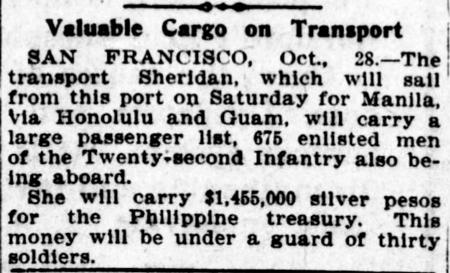
Burial:
Greenwood Cemetery
Zanesville
Muskingum County
Ohio, USA
Plot: Section: East Center Square/5
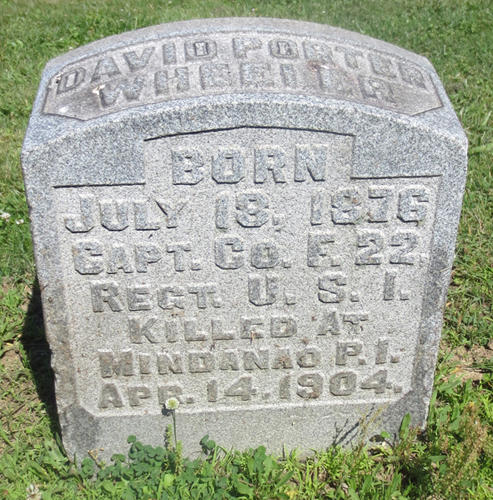
Grave marker for David
P. Wheeler
The inscription indicates that he was Captain of Company F 22nd
Regiment United States Infantry
Photo by Nancy Ann Mull Buchanan from the Find A Grave website
**********************
Battery Wheeler
In late 1904 construction was
begun on a coastal defense artillery position at Fort Mills, on
the island
of Corregidor, at the mouth of Manila Bay in the Philippines. In
1909 construction was ended, with
two M1895 Coastal Defense 12 inch guns installed on M1901
disappearing carriages, and the position
was named Battery Wheeler, in honor of CPT David P. Wheeler of
the 22nd Infantry.
The No. 1 gun was an M1895 12
inch gun, serial number 7, built in 1900 by Bethlehem Steel in
Bethlehem, Pennyslvania.
The barrel was relined in 1935. Its M1901 disappearing carriage
was serial number 13, made in 1907 by the
Watertown Arsenal in Watertown, Massachusetts.
The No. 2 gun was an M1895 12
inch gun, serial number 36, built in 1900 by the Watervliet
Arsenal at Watervliet, New York.
Its barrel was relined in 1936. Its M1901 disappearing carriage
was serial number 12, made in 1907 by the
Watertown Arsenal in Watertown, Massachusetts.
A spare gun was also part of the battery, and it was serial number 10, built in 1898 by Bethlehem Steel.
The guns had a reported muzzle velocity of 2257 fps.
Battery Wheeler saw action
against the Japanese in 1942, and was captured by them during the
fall of the
Philippines that year. It again saw action, this time against
American forces, in February 1945, and was
recaptured by the US Army that month.
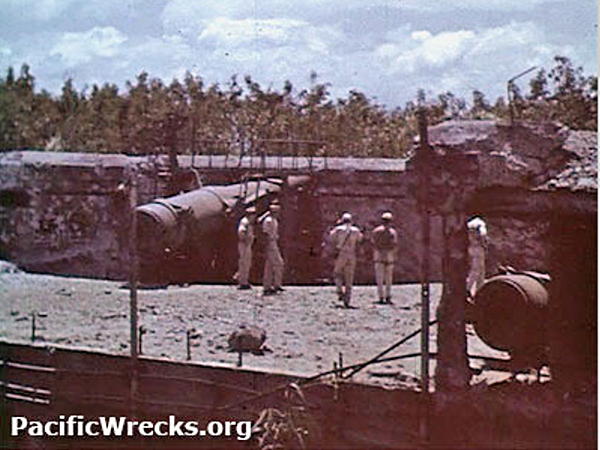
Battery Wheeler as it looked at the end of WW2.
Photo by Edwin Fitchett 1946
From the PacificWrecks website
Battery Wheeler
Location
Located on Corregidor Island facing southwest towards Manila Bay,
but could also target Mariveles to the northwest.
Construction
Built by the US Army, construction commenced during 1904 and was
completed during 1909 at a cost of $244,600.
Named in honor of Captain David P. Wheeler, 22nd U.S. Infantry
who died of wounds received in action on
April 14, 1904 at Taraca, Mindanao.
Emplaced two 12" (305mm) guns on Model 1901 disappearing
carriages, capable of firing to 17,000 yards (nearly 10 miles).
Their 1,000 lbs shells required a 270 lb (122.7 kg) bagged
charge. Rate of fire was at or better than 2 per minute, and with
a field of fire of 220 degrees. Maximum rate of fire was better
than two rounds per minute. The length of the rifled bore
was 35' (10.7 m). The traverse of each gun was limited to 170
degrees but because the centers of traverse are offset 50
degrees,
the combined field of the two guns enabled the battery to cover a
220 degree field of fire. The guns were proof fired during 1909,
making Battery Wheeler the first of the Corregidor gun batteries
made operational.
Wartime History
Manned by a gun crew of twenty-two men of Battery C, 59th Coast
Artillery commanded by Captain Harry W. Schenck.
Battery Wheeler fired on Japanese forces in defense of Corregidor
during 1942.
On March 24, 1942, a Japanese aircraft dropped an aerial bomb
that impacted the No. 1 gun and damaged the traversing rollers.
Repaired within 24 hours, traversing became difficult thereafter.
The guns remained in action throughout April then were
disabled by their crews prior to surrender.
After the surrender of Corregidor, the Japanese required American
prisoners of war to completely dismantle one
gun carriage for parts used to restore the other gun. The battery
was occupied by the Japanese until February 1945.
On February 16, 1945, it was thought that Battery Wheeler was
clear of Japanese, but they managed to reoccupy the battery.
Ultimately, three days of fighting was required before they were
neutralized.
Today, the No. 2 gun, Watervliet
No. 36, is laying in the emplacement, its carriage having been
completely dismantled.
The No. 1 gun, Bethlehem No. 7, is now mounted in Watertown
carriage No. 12. The spare barrel, Bethlehem No. 10,
lays just outside of the Battery's entrance.
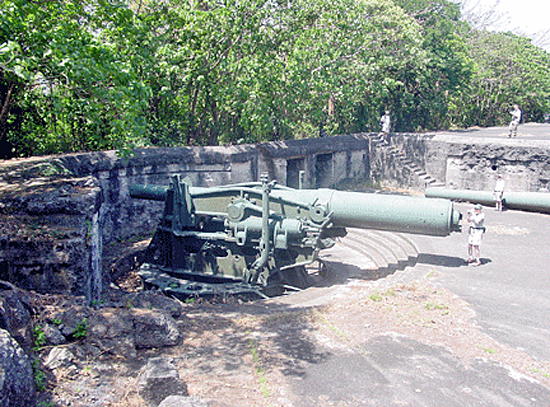
The No. 2 gun mount of Battery Wheeler
as it looks today.
A great deal of the gun carriage is missing. The huge size of the
gun's breech
can be judged by the size of the man standing next to it.
Photo from The Coast Defense Study Group,Inc.
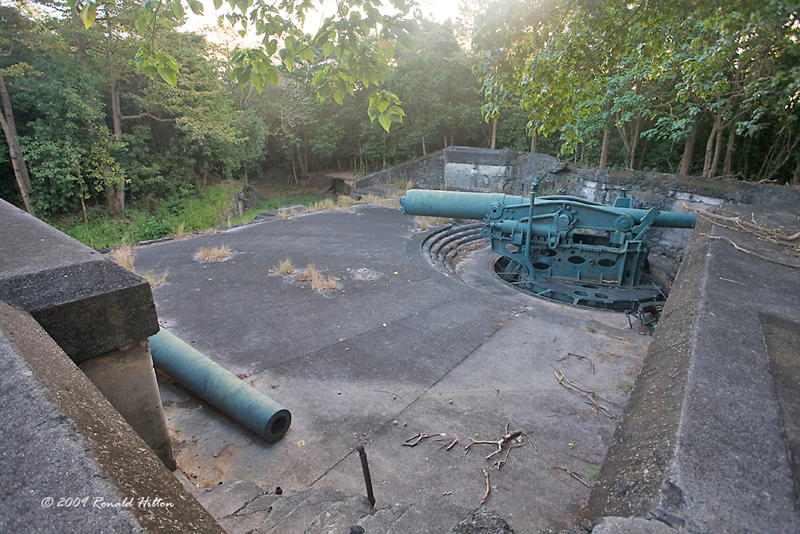
Battery Wheeler's No. 2 gun mount
today.
In the left of the photo is the gun tube of the No. 2 gun. The
No. 1 gun sits in the carriage that originally held the No. 2
gun.
The damaged guns and gun carriages were dismantled by the
Japanese in order to make one complete serviceable gun.
The No. 1 gun was originally in its mount on the other side of
the concrete wall in the far left of the photo.
Photo copyright © Ronald Hilton from the Flickr website
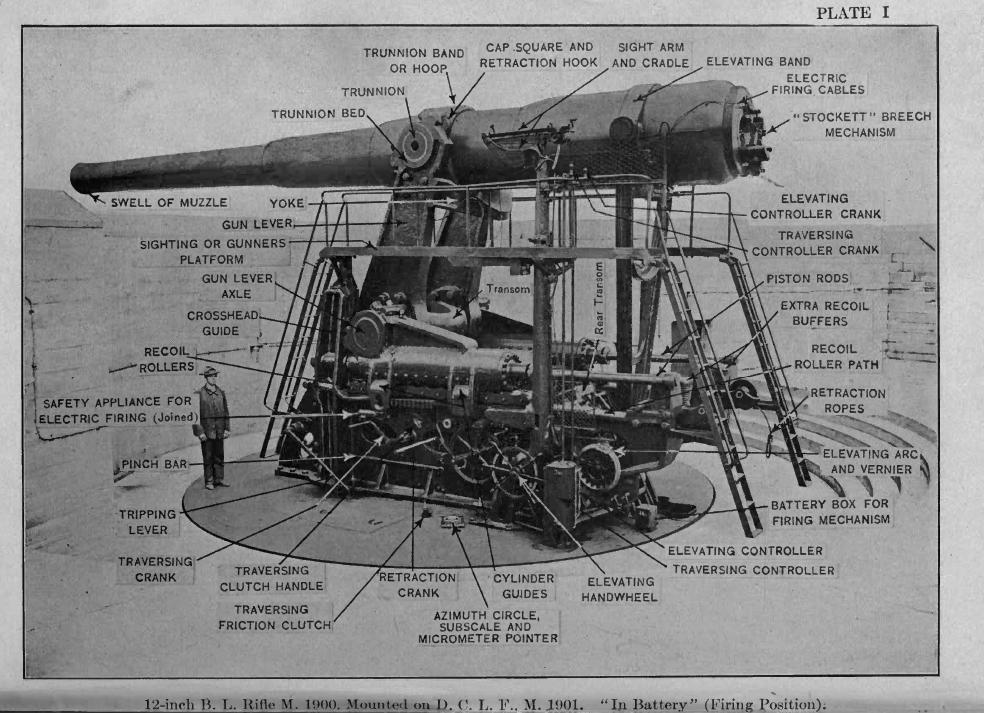
A later model 12 inch gun mounted on
the same kind of M1901 disappearing carriage as the guns at
Battery Wheeler.
This gun is in firing position, raised up on the carriage to
clear over the protecting wall.
Sources:
Official Army Registers for 1898, 1899, 1900, 1901, 1902, 1904
Annual Reports of the War Department for the
Fiscal Year Ended June 30, 1898, Report of the Major-General
Commanding the Army, Washington, Government Printing Office 1898
Annual Reports of the War Department for the
Fiscal Year Ended June 30, 1901, Report of the Lieutenant-General
Commanding the Army Part 3, Washington, Government Printing
Office 1901
A History of the Twenty-second United States
Infantry Compiled From Official Records,
Major O. M. Smith, Captain R. L. Hamilton, Captain W. H. Wassell,
Press of E. C. McCullough & Co., Inc., Manila, P.I. 1904
Biographical Register of the Officers and
Graduates of the U.S. Military Academy at West Point, New York
Since Its Establishment in 1802
by Brevet-Major-General George W. Cullum, Supplement, Volume V
1900-1910, Seemann and Peters, Saginaw, Michigan 1910
Thirty-sixth Annual Reunion of the Association
& Graduates of the United States Military Academy, at West
Point, New York,
June 13, 1905, Seemann and Peters, Saginaw, Michigan 1905
United States Military Academy Class Album, 1898, Pach Brothers Publishers
Combat Diary Episodes From the History of the
Twenty-Second Regiment, 1866-1905
by A. B. Feuer, Praeger Publishers, One Madison Avenue, New York,
NY 1991
United States Military Academy Library
CDNC California Digital Newspaper Collection
The Corregidor Historic Society
The Coast Defense Study Group,Inc.
Home | Photos | Battles & History | Current |
Rosters & Reports | Medal of Honor | Killed
in Action |
Personnel Locator | Commanders | Station
List | Campaigns |
Honors | Insignia & Memorabilia | 4-42
Artillery | Taps |
What's New | Editorial | Links |